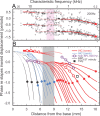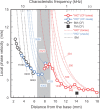Traveling waves on the organ of corti of the chinchilla cochlea: spatial trajectories of inner hair cell depolarization inferred from responses of auditory-nerve fibers
- PMID: 22855802
- PMCID: PMC3436599
- DOI: 10.1523/JNEUROSCI.1138-12.2012
Traveling waves on the organ of corti of the chinchilla cochlea: spatial trajectories of inner hair cell depolarization inferred from responses of auditory-nerve fibers
Abstract
Spatial magnitude and phase profiles for inner hair cell (IHC) depolarization throughout the chinchilla cochlea were inferred from responses of auditory-nerve fibers (ANFs) to threshold- and moderate-level tones and tone complexes. Firing-rate profiles for frequencies ≤2 kHz are bimodal, with the major peak at the characteristic place and a secondary peak at 3-5 mm from the extreme base. Response-phase trajectories are synchronous with peak outward stapes displacement at the extreme cochlear base and accumulate 1.5 period lags at the characteristic places. High-frequency phase trajectories are very similar to the trajectories of basilar-membrane peak velocity toward scala tympani. Low-frequency phase trajectories undergo a polarity flip in a region, 6.5-9 mm from the cochlear base, where traveling-wave phase velocity attains a local minimum and a local maximum and where the onset latencies of near-threshold impulse responses computed from responses to near-threshold white noise exhibit a local minimum. That region is the same where frequency-threshold tuning curves of ANFs undergo a shape transition. Since depolarization of IHCs presumably indicates the mechanical stimulus to their stereocilia, the present results suggest that distinct low-frequency forward waves of organ of Corti vibration are launched simultaneously at the extreme base of the cochlea and at the 6.5-9 mm transition region, from where antiphasic reflections arise.
Figures





Similar articles
-
Timing of spike initiation in cochlear afferents: dependence on site of innervation.J Neurophysiol. 1987 Aug;58(2):379-403. doi: 10.1152/jn.1987.58.2.379. J Neurophysiol. 1987. PMID: 3655874
-
Threshold tuning curves of chinchilla auditory-nerve fibers. I. Dependence on characteristic frequency and relation to the magnitudes of cochlear vibrations.J Neurophysiol. 2008 Nov;100(5):2889-98. doi: 10.1152/jn.90637.2008. Epub 2008 Aug 13. J Neurophysiol. 2008. PMID: 18701751 Free PMC article.
-
Mechanical bases of frequency tuning and neural excitation at the base of the cochlea: comparison of basilar-membrane vibrations and auditory-nerve-fiber responses in chinchilla.Proc Natl Acad Sci U S A. 2000 Oct 24;97(22):11744-50. doi: 10.1073/pnas.97.22.11744. Proc Natl Acad Sci U S A. 2000. PMID: 11050204 Free PMC article.
-
Theory of cochlear mechanics.Hear Res. 1980 Jun;2(3-4):171-82. doi: 10.1016/0378-5955(80)90055-6. Hear Res. 1980. PMID: 6997254 Review.
-
The cortilymph wave: Its relation to the traveling wave, auditory-nerve responses, and low-frequency downward glides.Hear Res. 2025 Jun;462:109279. doi: 10.1016/j.heares.2025.109279. Epub 2025 Apr 16. Hear Res. 2025. PMID: 40253777 Review.
Cited by
-
Energy Flux in the Cochlea: Evidence Against Power Amplification of the Traveling Wave.J Assoc Res Otolaryngol. 2015 Oct;16(5):581-97. doi: 10.1007/s10162-015-0529-5. Epub 2015 Jul 7. J Assoc Res Otolaryngol. 2015. PMID: 26148491 Free PMC article.
-
Adaptation and spectral enhancement at auditory temporal perceptual boundaries - Measurements via temporal precision of auditory brainstem responses.PLoS One. 2018 Dec 20;13(12):e0208935. doi: 10.1371/journal.pone.0208935. eCollection 2018. PLoS One. 2018. PMID: 30571726 Free PMC article.
-
Mechanical tuning and amplification within the apex of the guinea pig cochlea.J Physiol. 2017 Jul 1;595(13):4549-4561. doi: 10.1113/JP273881. Epub 2017 May 21. J Physiol. 2017. PMID: 28382742 Free PMC article.
-
The spatial buildup of compression and suppression in the mammalian cochlea.J Assoc Res Otolaryngol. 2013 Aug;14(4):523-45. doi: 10.1007/s10162-013-0393-0. Epub 2013 May 21. J Assoc Res Otolaryngol. 2013. PMID: 23690278 Free PMC article.
-
Tuning of SFOAEs Evoked by Low-Frequency Tones Is Not Compatible with Localized Emission Generation.J Assoc Res Otolaryngol. 2015 Jun;16(3):317-29. doi: 10.1007/s10162-015-0513-0. Epub 2015 Mar 27. J Assoc Res Otolaryngol. 2015. PMID: 25813430 Free PMC article.
References
-
- Cai H, Temchin AN, Ruggero MA. Phase-frequency functions for chinchilla auditory-nerve fibers with characteristic frequencies beyond the phase locking range. Paper presented at 32nd Association for Research in Otolaryngology Midwinter Meeting; February; San Diego, CA. 2009.
-
- Charaziak K, Siegel J. Evaluating frequency selectivity in humans and chinchillas with stimulus-frequency otoacoustic emission tuning curves. Paper presented at 35th Association for Research in Otolaryngology Midwinter Meeting; February; San Diego, CA. 2012.
-
- Cooper NP, Rhode WS. Fast travelling waves, slow travelling waves and their interactions in experimental studies of apical cochlear mechanics. Audit Neurosci. 1996;2:289–299.
-
- Cooper NP, Yates GK. Nonlinear input-output functions derived from the responses of guinea-pig cochlear nerve fibres: variations with characteristic frequency. Hear Res. 1994;78:221–234. - PubMed
Publication types
MeSH terms
Grants and funding
LinkOut - more resources
Full Text Sources
